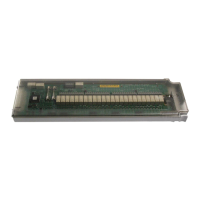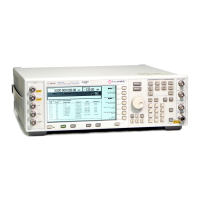1-55
Troubleshooting
Troubleshooting Assembly–Level Problems
1206 20 GHz IQ Modulator
1. If the power supplies 8V AF, 2.5V AF, 9V AFSW, 12V AFSW, 15V VLIMF, or −15VSWBIAS fail,
refer to the table on page 1-52, and check the supplies used by the A35 I/Q Modulator as they
leave A26 MID connector.
If the signals are good at the A26 MID connector, replace the A35 I/Q Modulator.
2. If the VD724 Doubler, test index 6, fails, replace the A35 I/Q Modulator.
3. If self-test TC672RF indexes 8, 9, 11, or 12 fail:
a. Remove the cable from J2 of the A29 20 GHz Doubler.
b. While measuring the signal at J2 with a spectrum analyzer, run self-test 1206. You should
see a +20 dBm signal at 5 GHz.
• If the signal is bad, troubleshoot the RF path.
• If the signal is good, and TC672RF indexes 8, 11, or 12 have failed, replace the
A35 I/Q Modulator.
• If the signal is good, and TC672RF indexes 9 has failed, you must also check the I/Q
signals from the A13 I/Q Multiplexer:
1. Remove the cable from J6 (I) of the A35 I/Q Modulator, and connect it to a DVM.
2. Execute a single 1206 self-test. The signal on the DVM should pulse to approximately
−0.165 Vdc.
If the signal is bad, refer to the A13 I/Q Multiplexer troubleshooting.
3. If the signal is good, reconnect the cable to J6, remove the cable to J7 (Q), and connect
this cable to the DVM.
4. Execute a single 1206 self-test. The signal on the DVM should pulse to approximately
a few millivolts.
If the signal is bad, refer to the A13 I/Q Multiplexer troubleshooting.
If both the I and Q signals are good, replace the A35 I/Q Modulator.
4. If self-test TC672RF indexes 10 fails, replace the A35 I/Q Modulator.

